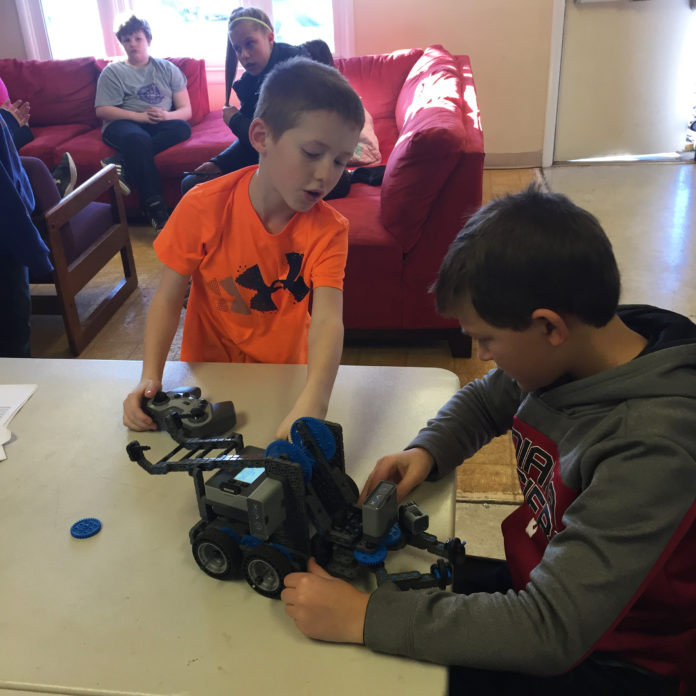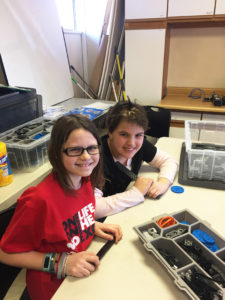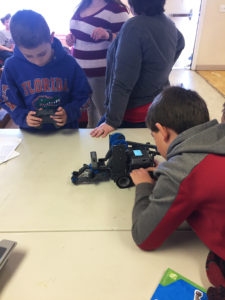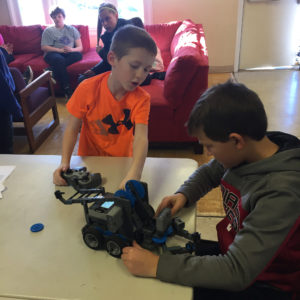
Wound up from a sedentary day in the classroom, children run into the Crown Street Community Center excited to build and test robots to prepare for an upcoming competition in Indianapolis.

The program, headed by professor of Spanish Robert Hershberger and coordinated by first-year Bonner scholars Megan McKinzie and Alexa Jenkins, seeks to introduce at-risk children in the Greencastle community to STEM, science, technology, engineering, and mathematics, topics by providing robot kits for the students to work with. McKinzie said that often these kids don’t realize their options in STEM fields; they may be struggling in reading skills because they don’t have a lot of support from home.
The Robotics Club isn’t Hershberger’s first experience with the Crown Street Community Center. He’s been working at the community center for years and creating new programs. This past summer, he met Chelle Hendershot, a fifth grade teacher at Tzouanakis, as he helped with “Camp Invention,” a camp that served families who couldn’t afford to send their children to summer camp. Hoping to continue working with some of these same children, Hendershot applied for and received a grant for robotics. In order to reach more kids, she and Hershberger decided to collaborate by starting a year-round robotics program at the community center.
Hershberger recruited some of his students from the Servicio en las Américas program over the summer to staff the robotics sessions. Because the program is only in its first year, Hershberger emphasizes that it is a “work in progress,” but that they are constantly developing new curriculum to better serve the students. “Community service is not always glamorous and an easy thing to do, but we’ve obviously learned from some of our mistakes,” Hershberger said.
From the beginning, the program garnered immense enthusiasm from the elementary students. At Tzouanakis, 180 students wanted to join the program, but resources were only available for 18 participants. This initial enthusiasm helped drive the program forward. McKinzie commented that from the start, “everything ran pretty smoothly...It’s not perfect yet, but we’re getting there.” Now, the kids are looking forward to attending a competition in February, which is one of the requirements for the grant that Hendershot received.

When asked about her dream for the program, Hendershot said that she wants to make an impact on kids’ lives so that they can consider STEM as a viable option in the future. “I’ve talked to several people as grown-ups that did something similar to this and it was the thing that kept them going through school,” Hendershot said. “Kids that hated school would enjoy it because of something like this hands-on fun that they can do.”
Working with the robots both inspires and challenges the young students, many of whom may have been struggling in school due to a lack of excitement. Hendershot mentioned that some even asked for robotics kits for Christmas because they were so excited to practice their new skills and continue their education.
Hershberger’s goal for the future is to “potentially give these kids a leg up in the pathway for future work in a STEM-related field, which is so important in this day and age.” Like all programs at the Crown Street Community Center, the Robotics Club provides after-school educational enrichment for children to help them get ahead in the future.
“We’ll never really know what the full benefit of the program is until fifteen, twenty years from now,” Hershberger said. “If we’ve been successful in introducing these STEM topics to these kids, and to give them some ideas about what their future could entail, then we’ve done our job.”
Hendershot highlighted the need for solid relationships between the DePauw students and the children, saying that the program “could be the one thing that keeps them on track or lets them fall through the cracks.”
Many of the kids were hand-picked because they were in danger of missing out on valuable opportunities in the future, like careers in the STEM field. They were falling behind in class or were discouraged in the school environment, and the robotics program is a way to recapture their enthusiasm.

Hershberger, Hendershot, and McKinzie all maintained that the program is always open to new volunteers. “I don’t know if college students always get how important it is to be consistent and committed, and what an important role they have with the kids, and how deeply the kids learn to love them in the short time they are together,” Hendershot said.
It is clear that working with the children in the program has made an impact on McKinzie. Although she had no prior interest in robotics, she has grown to love the program because of the time she spends with the children, watching them grow as they develop problem-solving skills in their work with the robots. What inspires her is “just seeing all the things that run through their head and the amazing ideas they have. A lot of them aren’t realistic but they don’t know that yet, so they’re not afraid to dream really big and that’s incredible to me.”


